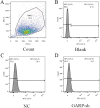Effect of GARP on osteogenic differentiation of bone marrow mesenchymal stem cells via the regulation of TGFβ1 in vitro
- PMID: 31198639
- PMCID: PMC6535220
- DOI: 10.7717/peerj.6993
Effect of GARP on osteogenic differentiation of bone marrow mesenchymal stem cells via the regulation of TGFβ1 in vitro
Abstract
Mesenchymal stem cells (MSCs), which have multipotential differentiation and self-renewal potential, are possible cells for tissue engineering. Transforming growth factor β1 (TGFβ1) can be produced by MSCs in an inactive form, and the activation of TGFβ1 functions as an important regulator of osteogenic differentiation in MSCs. Recently, studies showed that Glycoprotein A repetitions predominant (GARP) participated in the activation of latent TGFβ1, but the interaction between GARP and TGFβ1 is still undefined. In our study, we successfully isolated the MSCs from bone marrow of rats, and showed that GARP was detected in bone mesenchymal stem cells (BMSCs). During the osteogenic differentiation of BMSCs, GARP expression was increased over time. To elucidate the interaction between GARP and TGFβ1, we downregulated GARP expression in BMSCs to examine the level of active TGFβ1. We then verified that the downregulation of GARP decreased the secretion of active TGFβ1. Furthermore, osteogenic differentiation experiments, alkaline phosphatase (ALP) activity analyses and Alizarin Red S staining experiments were performed to evaluate the osteogenic capacity. After the downregulation of GARP, ALP activity and Alizarin Red S staining significantly declined and the osteogenic indicators, ALP, Runx2, and OPN, also decreased, both at the mRNA and protein levels. These results demonstrated that downregulated GARP expression resulted in the reduction of TGFβ1 and the attenuation of osteoblast differentiation of BMSCs in vitro.
Keywords: Bone marrow mesenchymal stem cell; Bone regeneration; GARP; TGFβ1.
Conflict of interest statement
The authors declare there are no competing interests.
Figures












Similar articles
-
Comparative Secretome Analysis of Mesenchymal Stem Cells From Dental Apical Papilla and Bone Marrow During Early Odonto/Osteogenic Differentiation: Potential Role of Transforming Growth Factor-β2.Front Physiol. 2020 Mar 6;11:41. doi: 10.3389/fphys.2020.00041. eCollection 2020. Front Physiol. 2020. PMID: 32210829 Free PMC article.
-
[Expression level of Dickkopf-1 protein in bone mesenchymal stem cells in Type 2 diabetic rats and its relationship with osteogenic activity].Zhong Nan Da Xue Xue Bao Yi Xue Ban. 2018 Sep 28;43(9):971-981. doi: 10.11817/j.issn.1672-7347.2018.09.007. Zhong Nan Da Xue Xue Bao Yi Xue Ban. 2018. PMID: 30333288 Chinese.
-
Orai1 mediates osteogenic differentiation via BMP signaling pathway in bone marrow mesenchymal stem cells.Biochem Biophys Res Commun. 2016 May 13;473(4):1309-1314. doi: 10.1016/j.bbrc.2016.04.068. Epub 2016 Apr 14. Biochem Biophys Res Commun. 2016. PMID: 27086849 Free PMC article.
-
[Icariin Promoted Osteogenic Differentiation of SD Rat Bone Marrow Mesenchymal Stem Cells: an Experimental Study].Zhongguo Zhong Xi Yi Jie He Za Zhi. 2015 Jul;35(7):839-46. Zhongguo Zhong Xi Yi Jie He Za Zhi. 2015. PMID: 26380448 Chinese.
-
GARP: A Key Target to Evaluate Tumor Immunosuppressive Microenvironment.Biology (Basel). 2021 Aug 27;10(9):836. doi: 10.3390/biology10090836. Biology (Basel). 2021. PMID: 34571713 Free PMC article. Review.
Cited by
-
Leucine rich repeat containing 32 accelerates tenogenic differentiation of tendon-derived stem cells and promotes Achilles tendon repair in rats.Exp Anim. 2023 Feb 21;72(1):9-18. doi: 10.1538/expanim.22-0009. Epub 2022 Aug 5. Exp Anim. 2023. PMID: 35934780 Free PMC article.
-
Bioinformatics analysis and identification of circular RNAs promoting the osteogenic differentiation of human bone marrow mesenchymal stem cells on titanium treated by surface mechanical attrition.PeerJ. 2020 Jul 13;8:e9292. doi: 10.7717/peerj.9292. eCollection 2020. PeerJ. 2020. PMID: 32742764 Free PMC article.
-
GARP promotes the proliferation and therapeutic resistance of bone sarcoma cancer cells through the activation of TGF-β.Cell Death Dis. 2020 Nov 17;11(11):985. doi: 10.1038/s41419-020-03197-z. Cell Death Dis. 2020. PMID: 33203838 Free PMC article.
-
GARP is a key molecule for mesenchymal stromal cell responses to TGF-β and fundamental to control mitochondrial ROS levels.Stem Cells Transl Med. 2020 May;9(5):636-650. doi: 10.1002/sctm.19-0372. Epub 2020 Feb 19. Stem Cells Transl Med. 2020. PMID: 32073751 Free PMC article.
-
A novel adiponectin receptor agonist (AdipoAI) ameliorates type 2 diabetes-associated periodontitis by enhancing autophagy in osteoclasts.J Periodontal Res. 2022 Apr;57(2):381-391. doi: 10.1111/jre.12969. Epub 2022 Jan 4. J Periodontal Res. 2022. PMID: 34984683 Free PMC article.
References
-
- Alkan EA, Lian PM, Schoolfield J, Guest GF, Cochran DL. Prevalence of dental implants and evaluation of peri-implant bone levels in patients presenting to a dental school: a radiographic cross-sectional 2-year study. International Journal of Oral and Maxillofacial Implants. 2018;33(1):145–151. doi: 10.11607/jomi.5756. - DOI - PubMed
-
- Cancedda R, Castagnola P, Cancedda FD, Dozin B, Quarto R. Developmental control of chondrogenesis and osteogenesis. International Journal of Developmental Biology. 2000;44(6):707–714. - PubMed
LinkOut - more resources
Full Text Sources
Other Literature Sources
Research Materials

